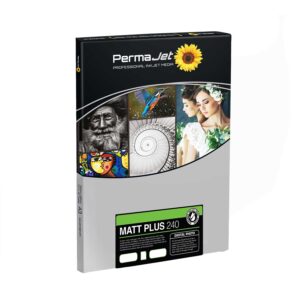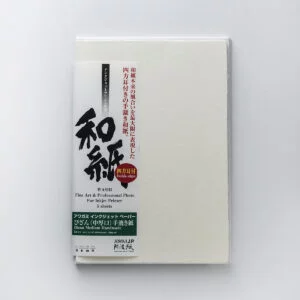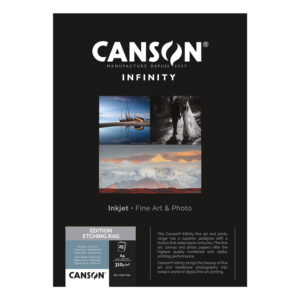What is Acid Free Paper?
Acid Free paper has pH of 7.0 or greater which means there are no acidic substances, primarily lignin and chemical compounds in the paper fibres. The presence of acid in the paper has detrimental effects of the quality of the paper and more importantly on the overall longevity of your prints. In this blog, we’ll delve deep into the topic of acid in digital photo and fine art inkjet paper. We’ll explore what acid is, its impact on print quality and longevity, and why acid-free paper is the preferred choice for professional photographers, Fine Art printmakers and artists. By the end of this article, you’ll have a thorough understanding of this essential aspect of paper selection.

What Is Acid in Paper?
The recipe for paper dates back to 86 BC in China and, since then, has not changed a great deal with the original recipe indicating a blend of hemp, wood, bamboo fibres and water. The main difference however is that modern manufacturing processes allow manufacturers to use wood pulp rather than raw wood. Wood pulp is cellulose fibres from wood, fibre crops and waste paper – hence why you may hear inkjet paper bases be referred to as Alpha Cellulose. The use of wood pulp means the modern processes yield far more paper from an individual tree and the ability to recycle paper makes it far more environmentally efficient. Whilst many photographic and fine art papers are made from alpha cellulose and cotton some specialist inkjet papers still use hemp and bamboo today.
The acid in the papers comes from a chemical compound in the wood pulp called lignin, when mixed with bleach is the refining process the lignin will slowly turn into hydrochloric acid as the paper ages. This acid will break down the chemical compounds with the paper, causing it to degrade and turn yellow. By removing this acid from the paper, this yellowing and degradation will not occur.
The Impact of Acid on Print Quality
When you print a photograph or fine art piece on acidic paper, you may notice several undesirable outcomes:
1. Yellowing: Acidic paper tends to yellow with age, causing your prints to lose their brightness and vibrancy. This is a significant concern, especially if you intend to display your work for an extended period.
2. Brittleness: Acidic paper becomes brittle over time, making it more susceptible to damage and creasing. This can lead to premature degradation of your prints.
3. Print Fading: Acidic paper can contribute to the fading of inks over time, reducing the archival quality of your prints.
Consider an old photograph or canvas it’s likely a yellowed and faded image with frayed edges. comes to mind. This is a perfect example of the detrimental effects of acid in paper. To ensure the longevity and vibrancy of your prints, it’s crucial to opt for acid-free inkjet paper.

What Is Acid-Free Inkjet Paper?
Acid-free inkjet paper is specially manufactured to be free of acidic substances like lignin and chemicals. Instead, it typically uses high-quality cotton or alpha cellulose fibers. Alternatively the raw material used to make the paper can be naturally acid free, for example cotton, hemp, kozo or mulberry. Acid free paper can last over 100 years and is the best solution for prints that you would like to last for many years to come. It is worth noting that where you might see paper that is not acid free, the technology used in the manufacturing process today means that prints made on these papers can often last 40 years plus.
What Is Archival/Conservation Inkjet Paper?
You may have heard the terms Archival or Conservation inkjet paper be used before and be wondering how that differs from Acid Free inkjet paper. Acid Free and Conservation grade papers are one in the same thing they are both acid free and made from a wood pulp/alpha cellulose base. Archival inkjet papers differ is that the base of the paper is manufactured from 100% Cotton. For a paper to be truly archival it must meet the international standard ISO 11108 and must meet the following criteria:
1. Acid-Free and Lignin-Free: Archival paper must exhibit either an acid-free composition or a pH level above 7 that is neutral. Additionally, it should be devoid of lignin, a material that can accelerate paper degradation.
2. No Unbleached Cotton Content: The paper must not include unbleached cotton, as its presence can diminish the paper’s lifespan.
3. Without Optical Brightening Agents (OBAs): Archival paper must be devoid of optical brightening agents (OBAs), which are chemical substances capable of modifying the paper’s appearance and potentially undermining its durability. We have a blog that explains what OBAs are and why it’s important when considering which paper to print on.
What are the benefits of Acid Free Inkjet Paper?
Acid free papers offer a wealth of benefits and should be considered if you are looking to print an image that will last many lifetimes. Don’t however completely disregard papers that contain acid. These can be great if you are looking for your prints to last up to 40 years or so, they also make fantastic greetings cards. Acid Free papers do tend to be more expensive so this should be an important consideration when making your choice. The benefits of Acid Free papers however are:
Acid-Free Paper Types for Fine Art and Photographic Prints
Alpha Cellulose Papers
Acid Free Alpha cellulose papers are a high-quality, acid-free option commonly used for fine art and photography printing. It is derived from purified wood pulp, ensuring exceptional durability and archival quality. Its smooth surface texture allows for precise ink placement, making it ideal for detailed prints. Acid Free Alpha Cellulose papers offer an economical way to reap the benefits of acid free prints, generally being cheaper than cotton based papers. Not all Alpha Cellulose papers are Acid Free so ensure to check each papers specification first.
Our favourite Acid Free Alpha Cellulose papers…
-
 PermaJet Matt Plus 240gsmFrom £11.63
PermaJet Matt Plus 240gsmFrom £11.63 -
 Hahnemühle Photo Matt Fibre 200gsmFrom £16.77
Hahnemühle Photo Matt Fibre 200gsmFrom £16.77 -
 Fotospeed Natural Textured Bright White 315gsmFrom £23.55
Fotospeed Natural Textured Bright White 315gsmFrom £23.55 -
 Canson Infinity PhotoGloss Premium RC 270gsmFrom £18.00
Canson Infinity PhotoGloss Premium RC 270gsmFrom £18.00
Baryta Paper
Baryta paper combines the qualities of traditional fibre-based photographic paper with modern inkjet printing technology. It features an acid-free alpha cellulose or cotton base, coated with a baryta (barium sulfate) layer, creating a glossy or semi-gloss surface. This paper is renowned for its ability to replicate the look and feel of traditional darkroom prints. Not all baryta papers are acid free so ensure to check each papers specification first.
Our favourite Acid Free Baryta papers…
-
 Canson Infinity Baryta Photographique II 310gsmFrom £12.40
Canson Infinity Baryta Photographique II 310gsmFrom £12.40 -
 Hahnemühle Photo Rag Baryta 315gsmFrom £43.60
Hahnemühle Photo Rag Baryta 315gsmFrom £43.60 -
 Ilford Galerie Gold Fibre Pearl 290gsmFrom £18.09
Ilford Galerie Gold Fibre Pearl 290gsmFrom £18.09
Fine Art Paper
Fine art matte paper, typically composed of acid-free alpha cellulose or cotton rag, provides a smooth and non-reflective surface. It’s an excellent choice for prints where a matte finish is desired, such as black-and-white photography or art reproductions. Whilst a paper might be labelled as being “Fine Art” this is not a gurantee Not all baryta papers are acid free so ensure to check each papers specification first.
Our favourite Acid Free Fine Art papers…
-
 Hahnemühle Bamboo 290gsmFrom £35.38
Hahnemühle Bamboo 290gsmFrom £35.38 -
 PermaJet Etching Rag 310gsmFrom £31.63
PermaJet Etching Rag 310gsmFrom £31.63 -
 Fotospeed Natural Soft Textured 315gsmFrom £23.55
Fotospeed Natural Soft Textured 315gsmFrom £23.55 -
 Awagami Bizan Medium Natural (Deckle Edge) 200gsmFrom £99.30
Awagami Bizan Medium Natural (Deckle Edge) 200gsmFrom £99.30
Cotton Rag Paper
Cotton rag paper, made from cotton fibres, is another premium choice for fine art and photography printing. This acid-free paper offers a luxurious texture and is often favoured by artists for its exceptional color reproduction and longevity. It’s worth noting that cotton rag often refers to the paper base as opposed to the classification so it may be that you find photographic cotton rag papers, baryta rag papers and fine art cotton rag papers.
Our favourite Acid Free Cotton Rag papers…
-
 Hahnemühle Photo Rag 308gsmFrom £38.12
Hahnemühle Photo Rag 308gsmFrom £38.12 -
 Canson Infinity Edition Etching Rag 310gsmFrom £12.94
Canson Infinity Edition Etching Rag 310gsmFrom £12.94 -
 PermaJet Baryta Rag 310gsmFrom £31.63
PermaJet Baryta Rag 310gsmFrom £31.63 -
 Ilford Galerie Textured Cotton Rag 310gsmFrom £33.16
Ilford Galerie Textured Cotton Rag 310gsmFrom £33.16
How to Identify Acid-Free Inkjet Paper
Choosing the right inkjet paper for your projects involves identifying whether it is acid-free. Manufacturers often label their paper products with terms like “acid-free,” “archival,” or “pH-neutral.” Additionally, you can look for certifications and industry standards, such as ISO 9706 or ISO 11108, which specify acid-free paper requirements.
Fortunately we have made determining if a paper is acid free or not much simpler. On each of our product pages you will find a simplified version of the papers specification, within which you will see if the paper is acid free or not.

Conclusion
In conclusion, the presence or absence of acid in digital photo and fine art inkjet paper is a critical consideration for photographers and artists alike. Opting for acid-free inkjet paper ensures your prints remain vibrant, durable, and true to your artistic vision for years to come. Whether you choose alpha cellulose, cotton rag, baryta or fine papers, selecting acid-free paper is a fundamental step toward achieving the highest quality and longevity in your fine art and photographic prints. Make the right choice today, and your work will continue to shine brightly for generations.
Still confused?
If you are still confused or would like to learn more regarding anything in the world of inkjet paper or printing, please don't hesitate to get in touch.



